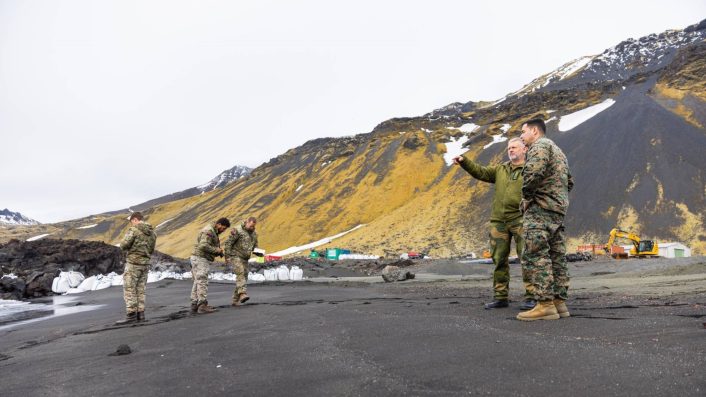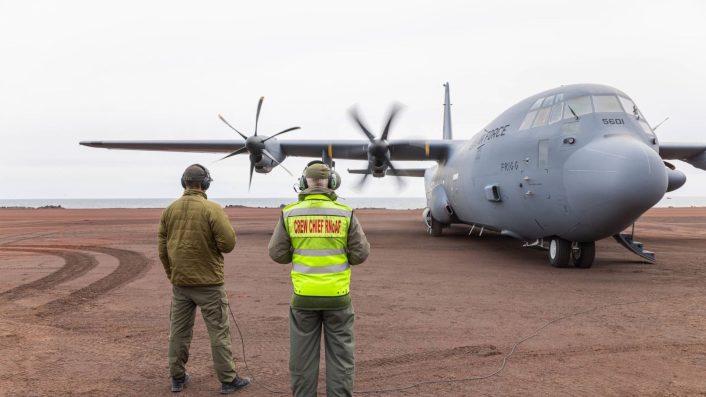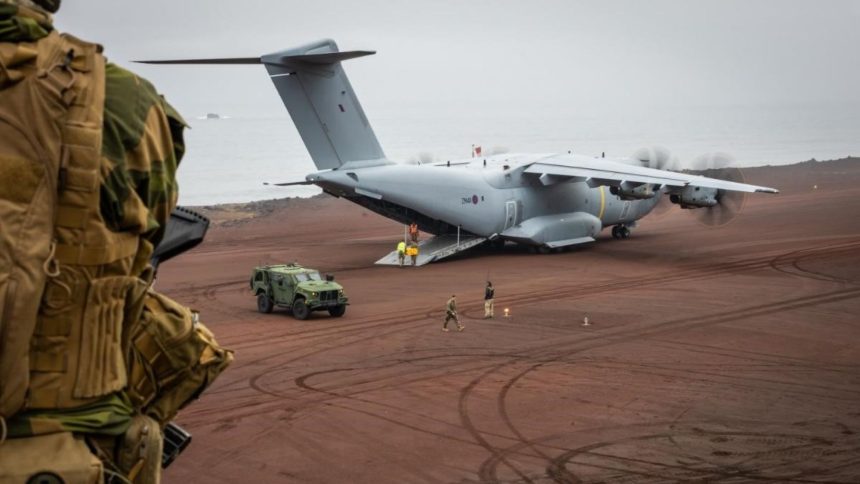The joint U.S., British and Norwegian mission saw the A400M transporting a JLTV, simulating a NMESIS system, and infantry in the High North.
The Royal Air Force (RAF) revealed on Oct. 9, 2025 a first-of-its-kind operation conducted in cooperation with the U.S. and Norway in late September. As part of the operation, an RAF A400M Atlas transport aircraft landed for the first time on Norway’s Jan Mayen island in the Norwegian Sea, airlifting there a U.S. Marine Corps JLTV (Joint Light Tactical Vehicle), as well as British, U.S. and Norwegian personnel.
Notably, the RAF disclosed the JLTV was meant to simulate the NMESIS (Navy/Marine Expeditionary Ship Interdiction System). The NMESIS forms a part of the Corps’ island-hopping Expeditionary Advanced Base of Operations (EABO) concept in the western Pacific, and was live-fired in the latest edition of Exercise Balikatan with the Philippines earlier this year.
The mission demonstrated the RAF’s “ability to deliver critical capabilities to austere locations, reinforcing NATO’s readiness in the High North.” According to the press release, operations were conducted from two locations on the island, supported by the Royal Marines and the Norwegian Armed Forces.
The trilateral effort between the U.K., U.S. and Norway had been a few months in the making, amid a hardening posture against Russia both eastwards in Europe and northwards towards the Polar regions. NATO says the High North is strategically vital, describing it as a gateway between North America and Europe and a key arena for securing transatlantic supply routes.
✈️ RAF A400M Lands on Remote Arctic Island ❄️
In a historic mission, the RAF demonstrated its ability to deliver critical capabilities to austere locations, reinforcing @NATO’s readiness in the High North.#A400M #HighNorth #WeAreNATO #AlwaysReady pic.twitter.com/FX1xzvNdpR
— Royal Air Force (@RoyalAirForce) October 9, 2025
Jan Mayen
The volcanic island of Jan Mayen is 377 sq. km. in size, located about 1,000 km west from the Norwegian mainland coast, sitting almost midway between Norway and Greenland, north of Iceland. The Norwegian Ministry of Defence reported on Jun. 19, 2025 a “joint reconnaissance” of the island with the U.K. and the U.S. to “strengthen understanding of the demanding Arctic conditions – and plan future training.”
The press release underlined Jan Mayen’s geographical significance in “Norway’s defense surface” for “ensuring allied freedom of maneuver in the Norwegian Sea,” and touched upon the renovation and infrastructure upgrade work of the existing Norwegian Cyber Defence Force and Norwegian Meteorological Institute based there. The station is regularly supported by Royal Norwegian Air Force (RNoAF) C-130 Hercules aircraft.
The RAF A400M’s landing at Jan Mayen also comes within the NATO Joint Expeditionary Force (JEF) framework, which comprises ten nations, including the U.K., Norway, Denmark, Finland, Iceland, Sweden, Estonia, Lithuania, Latvia and the Netherlands. The JEF’s ongoing Exercise TARASSIS also saw two RAF Typhoons from RAF Lossiemouth “delivering air support in Norway’s High North […] proving the ability to respond fast, anywhere,” the U.K. said on Oct. 10.
🇬🇧🇳🇴🇺🇸 The Royal Air Force’s A400M military transport aircraft made its first landing on an unprepared airfield on the volcanic island of Jan Mayen in the Norwegian Sea.
This unique operation in the High North involved the Norwegian Armed Forces, the British Royal Marines, and… pic.twitter.com/RrA7AXNTmf
— Visioner (@visionergeo) September 26, 2025
The Forsvaret press release quoted Lt. Col. Gard Ommedal of the Defence Staff, who led the June reconnaissance mission. “Jan Mayen is Norwegian territory and thus also part of NATO’s area of responsibility,” he said. “It is therefore important that both Norwegians and allies are familiar with the geography, as well as the special and very demanding conditions on Jan Mayen. So the fact that we are now conducting reconnaissance together […] contributes to planning possible future activities,” Ommedal added.
A400M and JLTV at Jan Mayen
The RAF A400M Atlas (British designation Atlas C.1), assigned to the 206 Squadron at RAF Brize Norton, transported the JLTV from “pre-positioned locations in Norway” to Jan Mayen to underscore its importance as a “key node for transatlantic supply routes and freedom of navigation in the Arctic.”
The video by the RAF showed the aircraft landing on the unpaved runway, as well as the loading and unloading operations and the movement on the island. Other tactical vehicles can also be seen traveling with the JLTV over the unpaved roads on hillocks, moving to the locations where they would simulate the NMESIS’ operations.
It should be noted that the Oshkosh JLTV used for the simulation manned, while NMESIS is an unmanned system based on an unmanned variant of the JLTV, designated the Remotely Operated Ground Unit for Expeditionary (ROGUE). “The JLTV simulated the Navy/Marine Expeditionary Ship Interdiction System (NMESIS), with operations conducted from two locations on the island,” the RAF press release said.
US Marines with 2nd Battalion, 11th Marine Regiment, 1st Marine Division, fire a Naval Strike Missile from a Navy/Marine Expeditionary Ship Interdiction System at Naval Air Station Point Mugu, California, June 28. They are the first US Marines to operate and fire the NMESIS. pic.twitter.com/j64Scdy98S
— Ryan Chan 陳家翹 (@ryankakiuchan) July 18, 2023
A Norwegian Armed Forces soldier is also seen releasing a FLIR Systems’s Black Hornet nano drone, used by small squad-level infantry units. The visit to Jan Mayen, located north of the G-I-UK (Greenland-Iceland-UK) gap, also comes after the intense alleged anti-submarine hunt for a Russian boat in lateAugust in the North Sea, mounted by U.S., U.K. and Norwegian forces.
‘Readiness to defend NATO in harsh environments’
“The RAF’s role in this mission highlights its capability to project air mobility into challenging environments, ensuring the Alliance’s readiness to operate in contested and extreme conditions,” the RAF’s press release added, highlighting the importance of the operation.

To operate in “harsh Arctic conditions, where weather and terrain demand meticulous planning” and “careful preparation,” the RAF planned “essential equipment, rations, and supplies […] from the outset,” said the service. “Critically, it underscores the importance of air power in enabling multi-domain operations and maintaining readiness in the High North.”
“By integrating seamlessly with Allied forces, the RAF [safeguards] freedom of navigation and [ensures] credible deterrence in the region,” added the statement The Sep. 23 NATO press release, which first announced the operation without mention of NMESIS, said that “Regular Allied activity in the region demonstrates NATO’s commitment to safeguarding freedom of navigation, ensuring access to critical sea lines of communication.”
“Operating jointly with Allies demonstrates both capability and commitment to defend Arctic islands, the High North, and surrounding waters if required,” said Vice Admiral Rune Andersen, Chief of the Norwegian Joint Headquarters in the NATO statement.

Long-running preparations at Jan Mayen
The Forsvaret’s Jun. 19 press release put the prior Norwegian, British and American reconnaissance work at Jan Mayen in context of the “security policy picture, especially after Russia’s attack on Ukraine.”
The statement further said that the existing station at Jan Mayen had been undergoing a “complete renovation” to support future activity on the “strategically important island.” A civilian contractor was carrying out the work, with the Armed Forces providing “transport resources, sometimes with help from our allies.”









